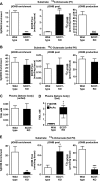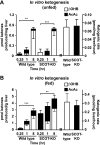Impact of peripheral ketolytic deficiency on hepatic ketogenesis and gluconeogenesis during the transition to birth
- PMID: 23689508
- PMCID: PMC3707678
- DOI: 10.1074/jbc.M113.454868
Impact of peripheral ketolytic deficiency on hepatic ketogenesis and gluconeogenesis during the transition to birth
Abstract
Preservation of bioenergetic homeostasis during the transition from the carbohydrate-laden fetal diet to the high fat, low carbohydrate neonatal diet requires inductions of hepatic fatty acid oxidation, gluconeogenesis, and ketogenesis. Mice with loss-of-function mutation in the extrahepatic mitochondrial enzyme CoA transferase (succinyl-CoA:3-oxoacid CoA transferase, SCOT, encoded by nuclear Oxct1) cannot terminally oxidize ketone bodies and develop lethal hyperketonemic hypoglycemia within 48 h of birth. Here we use this model to demonstrate that loss of ketone body oxidation, an exclusively extrahepatic process, disrupts hepatic intermediary metabolic homeostasis after high fat mother's milk is ingested. Livers of SCOT-knock-out (SCOT-KO) neonates induce the expression of the genes encoding peroxisome proliferator-activated receptor γ co-activator-1a (PGC-1α), phosphoenolpyruvate carboxykinase (PEPCK), pyruvate carboxylase, and glucose-6-phosphatase, and the neonate's pools of gluconeogenic alanine and lactate are each diminished by 50%. NMR-based quantitative fate mapping of (13)C-labeled substrates revealed that livers of SCOT-KO newborn mice synthesize glucose from exogenously administered pyruvate. However, the contribution of exogenous pyruvate to the tricarboxylic acid cycle as acetyl-CoA is increased in SCOT-KO livers and is associated with diminished terminal oxidation of fatty acids. After mother's milk provokes hyperketonemia, livers of SCOT-KO mice diminish de novo hepatic β-hydroxybutyrate synthesis by 90%. Disruption of β-hydroxybutyrate production increases hepatic NAD(+)/NADH ratios 3-fold, oxidizing redox potential in liver but not skeletal muscle. Together, these results indicate that peripheral ketone body oxidation prevents hypoglycemia and supports hepatic metabolic homeostasis, which is critical for the maintenance of glycemia during the adaptation to birth.
Keywords: Coenzyme A Transferase; Gluconeogenesis; Glucose Homeostasis; Ketone Body Metabolism; Liver Metabolism; NMR Substrate Fate Mapping; Neonatal Metabolism; Redox; Tricarboxylic Acid (TCA) Cycle.
Figures






Similar articles
-
Successful adaptation to ketosis by mice with tissue-specific deficiency of ketone body oxidation.Am J Physiol Endocrinol Metab. 2013 Feb 15;304(4):E363-74. doi: 10.1152/ajpendo.00547.2012. Epub 2012 Dec 11. Am J Physiol Endocrinol Metab. 2013. PMID: 23233542 Free PMC article.
-
Impairments of hepatic gluconeogenesis and ketogenesis in PPARα-deficient neonatal mice.Am J Physiol Endocrinol Metab. 2014 Jul 15;307(2):E176-85. doi: 10.1152/ajpendo.00087.2014. Epub 2014 May 27. Am J Physiol Endocrinol Metab. 2014. PMID: 24865983 Free PMC article.
-
Obligate role for ketone body oxidation in neonatal metabolic homeostasis.J Biol Chem. 2011 Mar 4;286(9):6902-10. doi: 10.1074/jbc.M110.192369. Epub 2011 Jan 5. J Biol Chem. 2011. PMID: 21209089 Free PMC article.
-
Metabolic adaptations to change of nutrition at birth.Biol Neonate. 1990;58 Suppl 1:3-15. doi: 10.1159/000243294. Biol Neonate. 1990. PMID: 2265217 Review.
-
Ketone body metabolism and its defects.J Inherit Metab Dis. 2014 Jul;37(4):541-51. doi: 10.1007/s10545-014-9704-9. Epub 2014 Apr 8. J Inherit Metab Dis. 2014. PMID: 24706027 Review.
Cited by
-
OXCT1 Enhances Gemcitabine Resistance Through NF-κB Pathway in Pancreatic Ductal Adenocarcinoma.Front Oncol. 2021 Nov 5;11:698302. doi: 10.3389/fonc.2021.698302. eCollection 2021. Front Oncol. 2021. PMID: 34804914 Free PMC article.
-
Ketogenesis prevents diet-induced fatty liver injury and hyperglycemia.J Clin Invest. 2014 Dec;124(12):5175-90. doi: 10.1172/JCI76388. Epub 2014 Oct 27. J Clin Invest. 2014. PMID: 25347470 Free PMC article.
-
A double-hit pre-eclampsia model results in sex-specific growth restriction patterns.Dis Model Mech. 2019 Feb 8;12(2):dmm035980. doi: 10.1242/dmm.035980. Dis Model Mech. 2019. PMID: 30683649 Free PMC article.
-
Cardiomyocyte-specific deficiency of ketone body metabolism promotes accelerated pathological remodeling.Mol Metab. 2014 Aug 13;3(7):754-69. doi: 10.1016/j.molmet.2014.07.010. eCollection 2014 Oct. Mol Metab. 2014. PMID: 25353003 Free PMC article.
-
Metabolic tinkering by the gut microbiome: Implications for brain development and function.Gut Microbes. 2014 May-Jun;5(3):369-80. doi: 10.4161/gmic.28681. Epub 2014 Mar 31. Gut Microbes. 2014. PMID: 24685620 Free PMC article. Review.
References
-
- Girard J., Ferré P., Pégorier J. P., Duée P. H. (1992) Adaptations of glucose and fatty acid metabolism during perinatal period and suckling-weaning transition. Physiol. Rev. 72, 507–562 - PubMed
-
- Ward Platt M., Deshpande S. (2005) Metabolic adaptation at birth. Semin. Fetal Neonatal Med. 10, 341–350 - PubMed
-
- Robinson A. M., Williamson D. H. (1980) Physiological roles of ketone bodies as substrates and signals in mammalian tissues. Physiol. Rev. 60, 143–187 - PubMed
-
- McGarry J. D., Foster D. W. (1980) Regulation of hepatic fatty acid oxidation and ketone body production. Annu. Rev. Biochem. 49, 395–420 - PubMed
Publication types
MeSH terms
Substances
Grants and funding
LinkOut - more resources
Full Text Sources
Other Literature Sources
Medical
Research Materials

